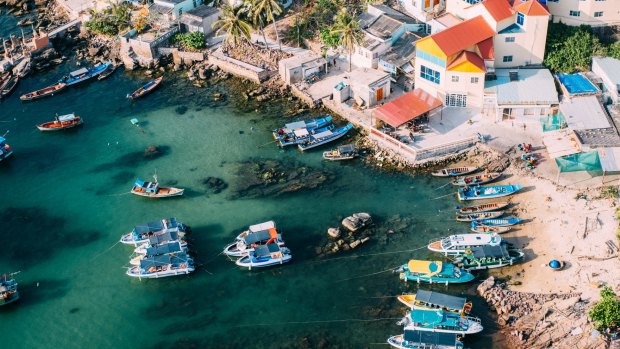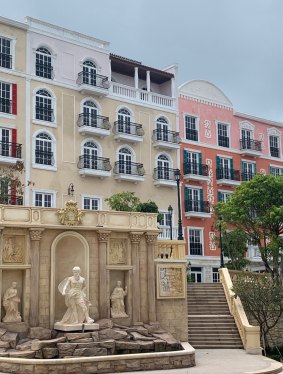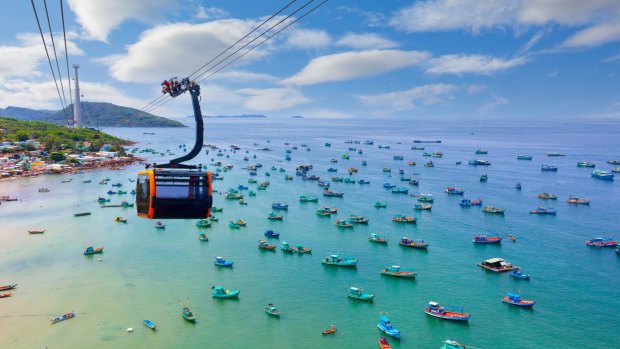This was published 1 year ago
Phu Quoc, Vietnam travel guide: The Mediterranean-style island village that's actually in Vietnam

Mediterranean Town on the Vietnamese island of Phu Quoc.Credit: Getty Images
A massive statue of a gladiator stands alongside Roman ruins. There's a trattoria with a Vespa parked out the front, right next to that sign to Pompeii which is apparently mere metres from Siena. There's just one problem: we're not in Italy. We're not even in the same hemisphere. But visit Mediterranean Town on the Vietnamese island of Phu Quoc and it soon becomes clear there's a surprise around every corner.
Phu Quoc sits off Cambodia in the Gulf of Thailand and is about an hour's flight from Ho Chi Minh City. Ten years ago the island was covered in dense jungle. Happily, much of that remains, with the northern end home to Phu Quoc National Park, designated a UNESCO Biosphere Reserve in 2010. In contrast, the southern part of the island is undergoing a building boom after some pandemic hiccups. It's home to the giant Sun Group's Mediterranean Town, mentioned above, but also one of the world's longest cable cars. There are new hotels and resorts, many of which have sprung up near the 17-kilometre Long Beach on the western side of the island.
So with such a mix of attractions it's a wonder that Phu Quoc has yet to establish itself on many Australian holiday radars, particularly seeing it has all of those things that have long wooed us to Vietnam: incredible food; beaches, warm and friendly people, and a fascinating history. And of course, enough good-natured chaos to make it intriguing: because a big part of Vietnam's attraction is that not everything makes immediate sense to outside eyes, reinforcing the fact that (thankfully) you're not in Kansas anymore.

Everything you associate with Italy is here: the fountains, the mosaics, the pasta, pots of red geraniums.Credit: Jane Richards
When in Rome
First question. Why would you build a hybrid version of Italy on a Vietnamese island? This is followed by how does this jumble of terracotta and pastel terraces that tumble down to the island-dotted waters of the Gulf of Thailand look so convincing? And, strange to say, not too tacky. Everything you associate with Italy is here: the fountains, the mosaics, the pasta, pots of red geraniums, all presented in the best-looking Italian streets anywhere. And then there's the not-so-convincing: the signs to Pompeii, the Roman Square, the gladiators and the ancient ruins.
This 30-hectare part-folly, part private investment, part tourist attraction includes villas, big and small hotels, apartments and shophouses along a path leading to the new Kiss Bridge and will delight and confuse. Eventually this project, by the giant Vietnamese Sun Group, will be full of apartment dwellers, businesses and holiday-makers but the day we visit painters, builders and gardeners are making final touches to Truman Show-esque streets where there is not a leaf out of place and hardly a person to be seen. But hey, Rome wasn't built in a day.

The Phu Quoc cable car offers 360-degree views of the An Thoi archipelago.Credit: iStock
The cable guys
One part of Mediterranean Town that is bustling is An Thoi Station where you can take a ride on the Phu Quoc cable car. This striking landmark from the sea and the air opened in 2018 and offers 360-degree views of the An Thoi archipelago. The ride itself is quite fast at 30 kilometres an hour, so brace yourself as you dip and glide over beaches and fishing villages for eight kilometres (it's the longest cable car of its type in the world), eventually landing on Hon Thom - dubbed Pineapple Island, a much-loved Vietnamese nature and water park. Spot coral reefs and fishing boats hauling in catches as you bob overhead.
The cable car ride costs about $9.50 return and takes about 15 minutes each way. It's a popular attraction for Vietnamese, so expect the cars to be packed in holiday periods. To send us on our way, a male Italian dance troupe dressed in black with red scarves and shirts unbuttoned to the waist, writhe, emote and flounce us a farewell. And why not.
From the heavens to hell
The black and white photo shows two men sitting at a table: one appears calm, hands resting in front of him. The other man's head is bowed - a picture of apparent anguish. But it's not until you read the caption under the photo on the walls of the notorious Phu Quoc Prison that the reason for this becomes apparent. The man who looks distressed is a former prison guard. But he is the one captured this time, snapped as he begs forgiveness from a man he once tortured at this notorious jail turned museum, which graphically illustrates torture, heroics and history.
This prison, also known as the Coconut Tree Prison Camp, was built by French colonialists in 1946 to house Vietnamese dissidents. It was later used in the Vietnam War by South Vietnam and American forces to detain communist soldiers.
It is not an easy place to visit. Rows of dummys in stifling cells illustrate cruel and bizarre methods of torture carried out on inmates while crudely dug tunnels highlight the heroism and desperation of those incarcerated. At one time this 400-hectare prison camp held up to 40,000 people. The exit through a gift shop may seem incongruous but is nothing compared with the incongruity behind the methods of torture devised here.
Some things fishy
Fish sauce has long been a staple of Vietnamese and Thai cooking. But Phu Quoc is home to the fish sauce, much sought after by lovers of Vietnamese and Thai cuisine across the world. Phu Quoc traditional fish sauce is made from anchovies that feed off particular types of local seaweed and plankton.
These high-protein anchovies are then salted, fermented and nurtured in huge wooden vats. Visit local makers in southern Phu Quoc but beware - there's a limit of two small bottles for those who are travelling by plane after some pungent mid-air mishaps. In 2021, the sauce was named part of Vietnam's national intangible cultural heritage by the Vietnamese Ministry of Culture, Sports and Tourism.
But this trademark sauce is not the only gift from the sea that Phu Quoc, also known as Pearl Island, enjoys. The pearls that gave the island its second moniker are on show and available to buy at the Ngoc Hien Pearl Farm in the island's south. Here, see how pearls are harvested or used to form sculptures and other artefacts.
Squid is another of the island's fishy delicacies. Join one of the small squid boats dotted off the beaches at dusk to catch your own or taste this and other fruits of the sea in various incantations at the Night Market in Phu Quoc's biggest town, Duong Dong, followed by coconut ice-cream for desert. Lastly is the fishy phenomenon known as Starfish Beach. This white-sand beach in the southern hamlet of Bai Sao is transformed at certain times of the year when pinkish starfish flood the shallows and shores to, so the locals say, 'bathe in the light of the moon'.
Wild at heart
Phu Quoc is gearing up for a tourist boom, boosted by an influx of new man-made developments. But nothing beats the allure of nature. Phu Quoc National Park in the island's north-east includes more than 27,000 hectares of forest and 20,000 hectares of surrounding ocean area. It has white-sand beaches, mountains, jungle treks, waterfalls, the rare slow loris, monkeys and other wildlife for those in search of some nature nurturing. Some areas are accessible for jeep or motorbike tours, others for hiking with local guides.
Not so fantastic plastic
Vietnam, like the rest of the world, has a plastic problem. While many of its beaches appear pristine, tidal rubbish is a problem. A national action plan on marine plastic aims to halve plastic ocean debris by 2025, and 75 per cent by 2030. There have also been recent local initiatives like a face-mask and plastic waste exchange scheme and new developments are encouraged to limit waste. But the best things guests can do anywhere is ask what their resort or hotel is doing about the problem, support anti-plastic initiatives and don't use plastic straws or bags when they are available and say why.
THE DETAILS
MORE
STAY
The Regent, Phu Quoc. The Regent, Phu Quoc, from $537 a night, including breakfast. See phuquoc.regenthotels.com
FLY
Vietnam Airlines flies daily to Phu Quoc from Ho Chi Minh City. See vietnamairlines.com
Jane Richards travelled to Phu Quoc as a guest of the Regent, Phu Quoc.
Sign up for the Traveller Deals newsletter
Get exclusive travel deals delivered straight to your inbox. Sign up now.